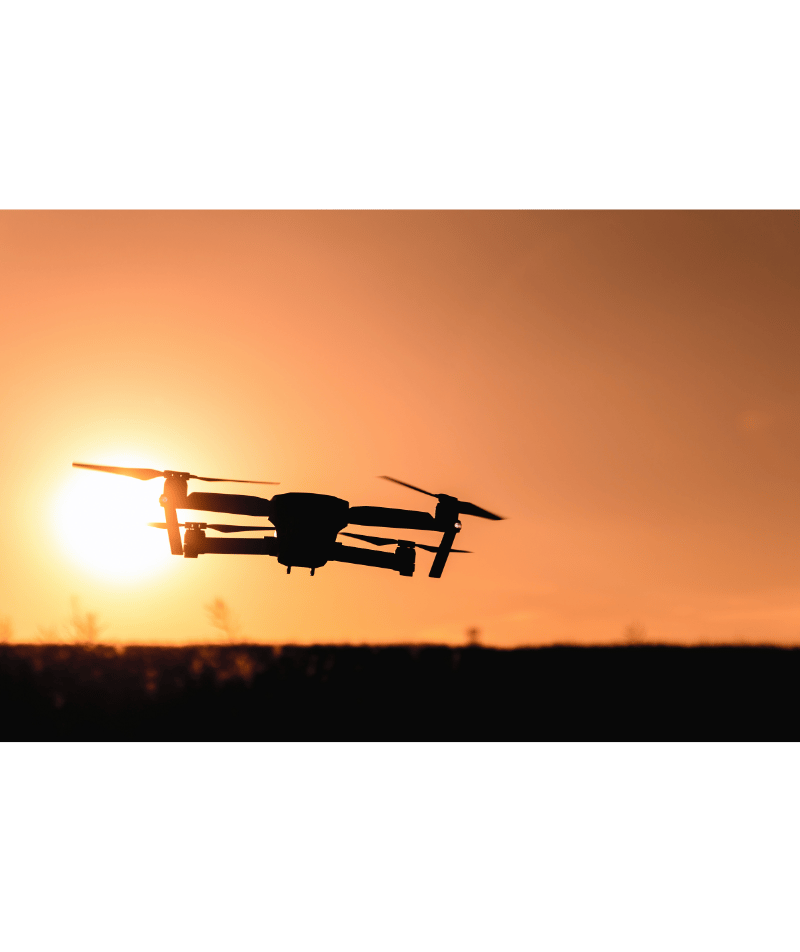Sky High Solutions: Drone Taxis as the Panacea for Urban Traffic Woes
In the bustling landscape of urbanization, where traffic congestion and vehicular pollution weigh heavily on city dwellers, a transformative solution emerges in the form of drone taxis. This opinion piece explores the potential of drone taxis as a panacea for urban traffic woes, promising not just relief from congestion but also a sustainable and efficient revolution in the way we commute.
Future of Technology Desk
1/13/20247 min read


As cities worldwide grapple with escalating congestion and the resultant environmental impact,
there emerges a promising beacon on the horizon – drone taxis.
The visionary statement by Nitin Gadkari, Union Minister for Road Transport and Highways in India, about the integration of helipads and drone landing facilities along national highways, paves the way for a potential revolution in urban transportation. This opinion piece delves into the transformative potential of drone taxis, emphasizing their role in alleviating road traffic congestion and fostering a future of cleaner, more efficient urban mobility.
The Urban Gridlock Conundrum:
Urbanization, a hallmark of the 21st century, has given rise to sprawling metropolises where roads, originally designed for a lesser vehicular load, now find themselves overburdened. The result is a daily ordeal for millions of commuters navigating through snarling traffic, leading to not only productivity losses but also a surge in vehicular emissions. The conventional approach of expanding road networks or bolstering public transit, while beneficial, cannot single-handedly address the burgeoning congestion crisis.
Enter Drone Taxis: Aerial Highways for Urban Relief:
The idea of drone taxis, commonly referred to as "flying cars" or "air taxis," heralds a paradigm shift in urban transportation. With their ability to soar above the terrestrial traffic, these autonomous aerial vehicles have the potential to unlock the skies and create a new dimension for commuting. The primary advantage lies in their capacity to de-congest existing road networks, providing a revolutionary solution to the perennial urban gridlock.
Reducing Road Traffic: Aerial Commuting Takes Flight:
The prospect of drone taxis navigating the urban airspace brings forth a host of benefits, starting with a significant reduction in road traffic. As autonomous passenger drones become an integral part of the transportation ecosystem, they can siphon off a substantial portion of the daily commuter load from conventional roads. This redistribution not only eases the strain on ground-level infrastructure but also promises quicker and more efficient point-to-point transportation.
Studies have indicated that even a modest adoption of drone taxis can lead to a substantial decrease in traffic density during peak hours. Commuters choosing aerial routes over congested roads could translate into a more fluid road network for those who still opt for traditional means of transportation. This shift can unlock hidden capacities within existing road infrastructure, contributing to a more balanced and efficient urban transport system.
Environmental Impact: Clearing the Air Above:
The environmental implications of reducing road traffic through the adoption of drone taxis are significant. Vehicular emissions, a major contributor to air pollution and climate change, could see a substantial decline. The electric propulsion systems of these aerial vehicles, coupled with the potential for increased adoption of renewable energy sources, promise a cleaner and greener mode of urban transportation.
Additionally, drone taxis operating in the airspace could potentially reduce noise pollution associated with ground-level traffic. This not only improves the quality of life for residents but also addresses a pressing concern in densely populated urban areas.
The Dubai Experiment: A Glimpse into the Future:
Dubai, a global frontrunner in embracing futuristic technologies, has already initiated trials for drone taxis. The autonomous flying cars, or taxi-drones, developed by companies like EHang and Volocopter, are set to reshape urban mobility in the city. The forward-thinking approach of Dubai's government reflects a commitment to exploring unconventional solutions for urban challenges.
The Dubai experiment, currently underway, envisions a regular flying taxi service that could streamline daily commuting, saving millions of driving hours and drastically reducing pollution levels. As Dubai aims to achieve 25% of transportation by unmanned vehicles by 2030, the world watches with anticipation for insights into the feasibility and impact of integrating drone taxis into daily urban life.
Overcoming Regulatory Hurdles: Paving the Skyways for Drone Taxis:
While the potential benefits of drone taxis are evident, the path to widespread adoption is riddled with regulatory complexities. Governments worldwide must navigate a delicate balance between ensuring safety and fostering innovation. Regulatory frameworks governing air traffic management, safety standards, and autonomous navigation systems must be carefully crafted to accommodate the unique challenges posed by aerial commuting.
International cooperation is paramount to establishing standardized regulations that can facilitate the seamless integration of drone taxis into global urban landscapes. Collaborative efforts between governments, aviation authorities, and industry stakeholders are necessary to create a regulatory environment that nurtures innovation while safeguarding public safety.
Infrastructure Development: Building Vertiports for a Skyborne Future:
The success of drone taxis hinges on the development of dedicated infrastructure – vertiports or drone stations – where these aerial vehicles can take off, land, and recharge. Urban planners and policymakers need to envision a network of vertiports strategically located across cities, ensuring accessibility and efficiency in aerial commuting.
Investments in vertiport infrastructure not only create a physical foundation for drone taxi operations but also generate employment opportunities and stimulate economic growth. The integration of vertiports with existing transportation hubs can enhance the overall connectivity of urban areas, fostering a seamless transition between ground and aerial modes of transportation.
Public Perception and Trust: Shaping the Future of Urban Mobility:
The successful adoption of drone taxis necessitates building public trust in the safety and reliability of these autonomous vehicles. Transparent communication, education campaigns, and real-world demonstrations can play a pivotal role in shaping public perception.
Governments and industry stakeholders must engage with communities to address concerns related to safety, privacy, and the potential impact on the existing urban landscape. Initiatives to showcase the benefits of drone taxis, both in terms of reducing congestion and mitigating environmental impact, can go a long way in garnering public support for this transformative mode of transportation.
Economic Viability: Balancing Innovation and Affordability:
While the promise of a skyborne future is exciting, economic considerations are paramount for the widespread adoption of drone taxis. The initial costs associated with developing and deploying the infrastructure, as well as manufacturing autonomous aerial vehicles, must be carefully weighed against the long-term benefits.
Governments and private enterprises need to collaborate to establish economically viable models for aerial commuting. Pricing structures, subsidies, and incentives can play a crucial role in making drone taxi services accessible to a broad spectrum of the population. Striking a balance between innovation and affordability is key to ensuring that the benefits of drone taxis are not confined to an elite few but are accessible to the masses.
The Road Ahead: Navigating Complexity for Urban Liberation:
As we envision a future where the skies become a bustling avenue for urban transportation, it is imperative to navigate the complexities that lie ahead. The roadmap to the widespread adoption of drone taxis involves overcoming regulatory hurdles, developing robust infrastructure, shaping public perception, and ensuring economic viability. The potential benefits – reduced road traffic, diminished vehicular emissions, and a leap towards sustainable urban mobility – make the journey worth undertaking.
International Collaboration for Standardized Regulations:
Harmonizing international regulations is a critical step in ensuring the global success of drone taxis. The establishment of standardized regulations governing air traffic management, safety standards, and autonomous navigation systems is imperative for fostering innovation and enabling seamless cross-border operations.
The creation of an international consortium, comprising governments, aviation authorities, and industry stakeholders, could facilitate the development of a unified regulatory framework. This collaborative approach would provide a blueprint for countries worldwide, encouraging the responsible integration of drone taxis into their urban landscapes.
Public-Private Partnerships for Vertiport Infrastructure:
Infrastructure development is a cornerstone of realizing the potential of drone taxis. Governments and private enterprises must forge partnerships to fund and build the vertiport infrastructure necessary for the seamless operation of aerial vehicles.
Public-private partnerships can leverage the strengths of both sectors – the innovation and efficiency of private enterprises, coupled with the regulatory oversight and public interest focus of governments. By combining resources and expertise, these partnerships can accelerate the establishment of a network of vertiports, transforming urban areas into interconnected hubs of ground and aerial transportation.
Community Engagement for Public Trust:
Building public trust is an ongoing process that requires active engagement with communities. Governments and industry stakeholders must prioritize transparent communication, educational initiatives, and community involvement to address concerns related to safety, privacy, and the impact on urban landscapes.
Real-world demonstrations, town hall meetings, and information campaigns can demystify the technology and showcase the benefits of drone taxis. By actively involving communities in the decision-making process, stakeholders can ensure that the public becomes a partner in, rather than a passive observer of, the evolution of urban transportation.
Innovative Financing Models for Economic Viability:
The economic viability of drone taxis hinges on the development of innovative financing models that balance the costs of infrastructure and technology against the long-term benefits. Governments, private enterprises, and financial institutions must collaborate to create sustainable financing mechanisms.
Subsidies, tax incentives, and public-private financing arrangements can play a crucial role in making drone taxi services affordable for a broad demographic. By exploring novel financial models, stakeholders can ensure that the benefits of aerial commuting are accessible to a diverse population, fostering inclusivity in the urban mobility revolution.
Conclusion: Soaring Towards Sustainable Urban Mobility
In conclusion, the integration of drone taxis into urban transportation systems holds the promise of transforming the way we commute, alleviating road traffic congestion, and contributing to a cleaner, more sustainable urban environment. The journey towards realizing this vision requires a coordinated effort on multiple fronts – regulatory harmonization, infrastructure development, community engagement, and economic viability.
As governments and industry stakeholders collaborate to overcome these challenges, the sky becomes a canvas for a new era of urban mobility. The potential benefits extend beyond the reduction of road traffic and vehicular emissions – drone taxis symbolize a leap towards a future where cities are interconnected through efficient, environmentally friendly, and innovative transportation solutions.
The road ahead may be complex, but the destination is one where urban liberation from congestion and pollution is not just a dream but a tangible reality. By embracing the transformative potential of drone taxis and navigating the challenges with collective determination, we can usher in an era of sustainable urban mobility that soars above the limitations of the past.
(With AI Input)
Context:
Amidst a dynamic landscape of urban transportation innovations, the recent approval of the world's first passenger-carrying flying taxi by China has ignited discussions on the transformative potential of autonomous aerial vehicles. Ehang's EH216-S AAV, achieving the monumental milestone of an airworthiness "type certificate," marks a groundbreaking leap in autonomous electric vertical take-off and landing (eVTOL) technology.
This milestone stands as a beacon for the global evolution of urban air mobility, transcending geographical boundaries. While China leads in regulatory advancements, notably allowing fully autonomous robotaxis on public streets, other regions like the United States and Europe are grappling with the integration of autonomous flying vehicles. The varying regulatory landscapes set the stage for an exploration of the diverse approaches and challenges shaping the future of aerial commuting.
Ehang's certification, anticipated to streamline global ambitions, prompts a closer examination of the broader implications for urban transportation. The company's vision of air taxis becoming commonplace within the next five years resonates not only with China's advancements but also with the increasing global interest in autonomous aerial solutions. As Ehang actively evaluates the launch of air taxi services within Chinese cities and collaborates on ventures like low-altitude tourism, the industry is at the cusp of a transformative era.
Contacts
enquiry@economicnations.org
(xx) 98-11-937-xxx (On verification)
